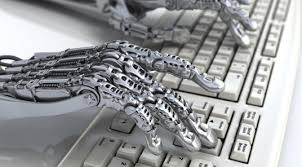 There's been some push-back recently regarding the benefits of the digital revolution. Julian Birkinshaw's book Fast/Forward suggests that organisations that embrace 'adhocracy', make smart intuitive decisions and act decisively will be the best prepared for uncertainty. Whilst it would seem that this almost defines small, agile firms, the book is full of examples of large corporations that have done this successfully.
There's been some push-back recently regarding the benefits of the digital revolution. Julian Birkinshaw's book Fast/Forward suggests that organisations that embrace 'adhocracy', make smart intuitive decisions and act decisively will be the best prepared for uncertainty. Whilst it would seem that this almost defines small, agile firms, the book is full of examples of large corporations that have done this successfully.
The core principles of Fast/Forward are built around what he calls 'The four paradoxes of progress'.
1. Creative destruction. A heretical idea challenges orthodoxy (Darwin or IKEA), disbelief of the establishment (Nokia), followed by the innovator becomes the establishment (Microsoft).
2. The more we know the less we understand. 'Whilst the human race is becoming collectively more knowledgeable every year, each of us (as individuals) is becoming relatively more ignorant'. 'Relatively' is the key word here due to the exponential increase in digital information available, compared to the linear rate of learning by us as individuals. Birkinshaw makes the case that team and networking can to some degree mitigate this paradox.
3. Connectivity and unpredictability. Competing on computational power has become a race to the bottom when it comes to solving complexity. 'There is a risk that the combination of new technology and old questions means that you end up with answers that are exactly wrong, rather than roughly right'. This is where the book makes the case for more agile management, particularly experimentation and learning.
4. Knowing and believing. Ironically, the torrent of data pouring into our lives may mean that we may inadvertently be making decisions by 'appeals to our emotions, our intuitive beliefs and our hidden values'. Fast/Forward suggests that this is no bad thing and may be a way of business leaders differentiating themselves. The example cited is Apple, where product design was as much about beliefs and emotions as it was about hard-headed business.
The concept of 'Adhocracy' is not new. Alvin Tofler explored the idea of flexibility in dealing with uncertainty in his 1973 book Future Shock. Birkinshaw updates the concept for the big data and machine learning age. He also neatly contrasts it with meritocracy and bureaucracy.
I was glad to see that rather than dismissing bureaucracy as an outmoded concept, he considers the merits of each and proposes a 'Trinity in Reality' model.
The main call-to-action for me is in the chapter 'Linking Strategy Back to Purpose'. 'Leaders need to make a stronger emotional connection to those around them, rather than allowing sterile, data-driven decision making to dominate their actions, reactions and responses'. Birkinshaw suggests that organisations should put 'pro-social' goals first, for example hire for attitude and train for skill (most organisations do the reverse). There are many examples cited of large organisations that clearly instil a sense of moral purpose (Tata, Arla, SouthWest Airlines) whilst innovating to break orthodox organisational models.
With all the excitement (and fear) around AI, big data and machine learning, it is easy to lose sight of vital business principles and values. The first half of Fast/Forward can be seen as a useful playbook for leaders wanting guidance on how to meld a technology revolution, give a clear sense of purpose for their organisations in an increasingly complex world and to embrace disruption.
Julian Birkinshaw is keynote speaker at the KIN Spring 2018 members' workshop 'Reimagining the Innovative Organisation'. This will take place at The Shard in London on 22nd March 2018.
-------------------
Fast/Forward
Authors: Julian Birkinshaw, Jonas Ridderstrale
Published 2017
Stanford Business Books
ISBN 9780804799539



















